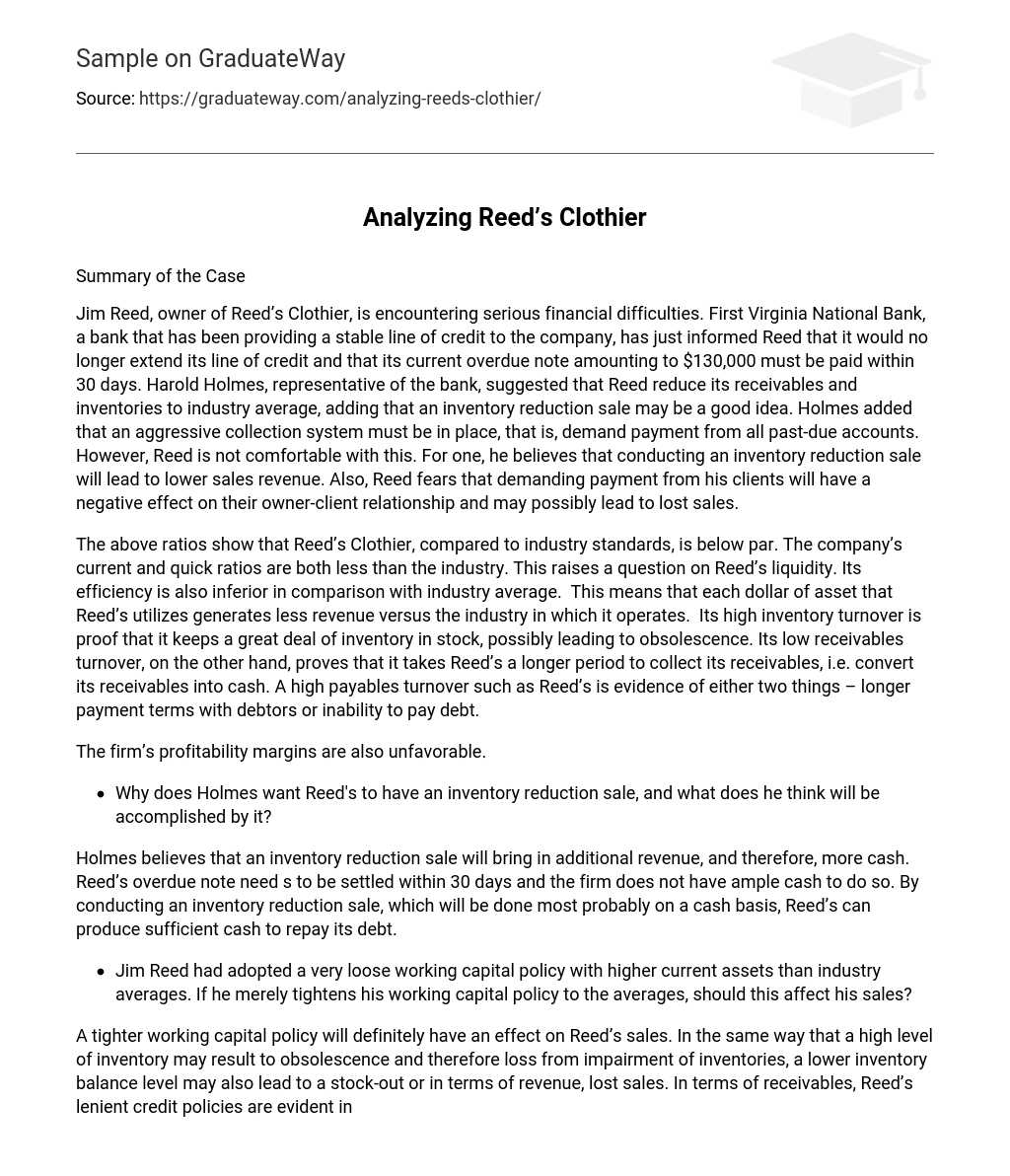Summary of the Case
Jim Reed, owner of Reed’s Clothier, is encountering serious financial difficulties. First Virginia National Bank, a bank that has been providing a stable line of credit to the company, has just informed Reed that it would no longer extend its line of credit and that its current overdue note amounting to $130,000 must be paid within 30 days. Harold Holmes, representative of the bank, suggested that Reed reduce its receivables and inventories to industry average, adding that an inventory reduction sale may be a good idea. Holmes added that an aggressive collection system must be in place, that is, demand payment from all past-due accounts. However, Reed is not comfortable with this. For one, he believes that conducting an inventory reduction sale will lead to lower sales revenue. Also, Reed fears that demanding payment from his clients will have a negative effect on their owner-client relationship and may possibly lead to lost sales.
The above ratios show that Reed’s Clothier, compared to industry standards, is below par. The company’s current and quick ratios are both less than the industry. This raises a question on Reed’s liquidity. Its efficiency is also inferior in comparison with industry average. This means that each dollar of asset that Reed’s utilizes generates less revenue versus the industry in which it operates. Its high inventory turnover is proof that it keeps a great deal of inventory in stock, possibly leading to obsolescence. Its low receivables turnover, on the other hand, proves that it takes Reed’s a longer period to collect its receivables, i.e. convert its receivables into cash. A high payables turnover such as Reed’s is evidence of either two things – longer payment terms with debtors or inability to pay debt.
The firm’s profitability margins are also unfavorable.
- Why does Holmes want Reed’s to have an inventory reduction sale, and what does he think will be accomplished by it?
Holmes believes that an inventory reduction sale will bring in additional revenue, and therefore, more cash. Reed’s overdue note need s to be settled within 30 days and the firm does not have ample cash to do so. By conducting an inventory reduction sale, which will be done most probably on a cash basis, Reed’s can produce sufficient cash to repay its debt.
- Jim Reed had adopted a very loose working capital policy with higher current assets than industry averages. If he merely tightens his working capital policy to the averages, should this affect his sales?
A tighter working capital policy will definitely have an effect on Reed’s sales. In the same way that a high level of inventory may result to obsolescence and therefore loss from impairment of inventories, a lower inventory balance level may also lead to a stock-out or in terms of revenue, lost sales. In terms of receivables, Reed’s lenient credit policies are evident in its average collection period of 74.1 days. If Reed’s decide to tighten its policies, its clients may shift to other suppliers that allow more flexible credit terms, therefore leading to lost sales. Also, if Reed’s decides to peg its policies with that of the industry average, it loses its advantage over the other suppliers and clients may now look at Reed’s as that company which is “one of our choices”.
Assuming that Reed’s can improve its operations to be in line with the industry averages, construct a 1995 pro forma income statement. Assume that net sales will be reduced 5 percent to $1,938,000 but that depreciation and amortization will not change but remain at $32,000.
- What type of inventory control system would you suggest to Jim Reed?
Inventory control systems aim to minimize the cost of a firm’s inventory. Reed must specifically implement an ABC inventory control system. Such inventory control method determines the weight of inventory items based on sales, usage, or cost criteria. ABC will allow Reed to exercise proper levels of control on individual stock keeping units based on its importance. Utilizing the ABC inventory method will help Reed to better manage its inventory.
How will Reed implement this in his Clothier? Simple, Reed must assign high-value items to Group A, medium-value items to Group B and low-value items to Group C. Reed must then ensure that appropriate levels of control are exercised in monitoring these items, with more focus being given to Group A as insufficient control over the items in this group may lead to obsolescence or even stock-out, both of which resulting to higher losses for the company than if something goes wrong with the items in Groups B and C.
- What type of accounts receivable control would you suggest to Jim Reed?
Jim Reed should prepare an aging schedule of its accounts receivables. An A/R Aging Schedule classifies receivables based on date of sale and when these will become due. It is a crucial tool in assessing the quality of a firm’s receivables. Patterns of delinquency, customers that are usually in default, among others, are highlighted in the schedule. It also pinpoints to management where collection efforts should be concentrated.
Utilizing an Aging Schedule will guarantee that Reed is able to follow up with clients that have past due accounts. Reed will have ample data about each client and will be more able to target customers that have the most past due accounts.





